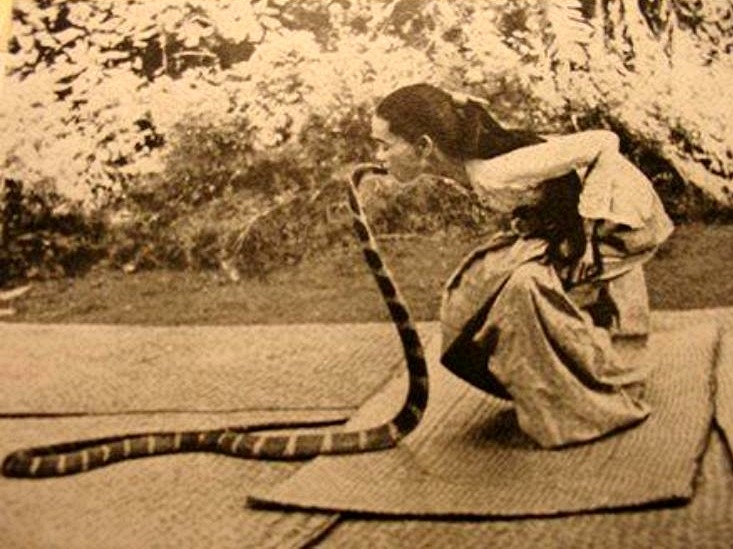In 1944, a remarkable documentary newsreel wowed the world. It showed the Burmese snake priestess Saya Hnin-Mahla performing a ritual required by her village. When the birth rate of male babies was low, the priestess was sent up the mountain to perform a dangerous dance. At the mouth of a cave, she lures out a King Cobra and must kiss it on the forehead … three times. A black-and-white, four-minute clip from the film still remains—you can see it here. She with her hair in a bun high at the back of her head, the cobra with its hood fully distended, it’s a fencing match without foils, a choreography of weave and duck, lunge and retreat, stillness and calm kiss.
According to the choreographer Agnes de Mille, naturalists, anthropologists, and artists were completely taken with this performance. Martha Graham, de Mille writes in her 1991 biography Martha, “was thunderstruck.” Graham had been working on a dance about Salome’s mother Herodias, a woman terrified of aging and the consequent loss of her seductive power. “Out of this extraordinary newsreel,” says de Mille, “she transfigured material into the deadly dance between Herodias and her mirror.”
It’s a fencing match without foils, a choreography of weave and duck, lunge and retreat, stillness and calm kiss.
On the same night, in 1944, both the beloved Appalachian Spring and the severe Herodiade premiered. Graham was moving from the young subject of America into the older realm of Greek myth. In 1946 she produced Cave of the Heart—the story of Medea; in 1947, Errand Into the Maze, which sees Ariadne entering the labyrinth to confront the Minotaur.
Fear was one of Graham’s great subjects, the facing of fear another. As we have all entered the labyrinth during this time of pandemic, many of us suddenly afraid of the simplest tasks and errands, Graham’s Errand Into the Maze, its score by Gian Carlo Menotti, offers a relevant allegory. Ariadne’s white dress is decorated with skeins of black rickrack, like zig-zaggy nerves, and her rattled mental state is made manifest in choreography of syncopated stresses. In this performance the incomparable Graham dancer Terese Capucilli draws us into her isolation, her clenched musculature. She wills her spirit to walk that rope-slim path into uncertainty. The dance is a masterpiece about self-mastery.
For a different kind of inspiration, take a look at “Ritual to the Sun,” the third part of Graham’s 1981 dance Acts of Light. It is a love song to the human body, and to the technique Graham pulled from it. The score by Carl Nielsen is tenderly Wagnerian. And costumed in Halston’s golden unitards, the dancers’ ecstatic shimmer, their sense of the divine, is thrilling. Notice, by the way, that the women are still wearing Graham’s signature hairstyle, that bun formed high at the back of the head, a nod to bravery in our errands.
For more gems from the Martha Graham archives, check out “Martha Matinees” at https://www.youtube.com/marthagrahamdancecompany. Look for these free online events on Wednesdays and Saturdays, at 2:30 EST.
